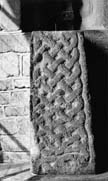Select a site alphabetically from the choices shown in the box below. Alternatively, browse sculptural examples using the Forward/Back buttons.
Chapters for this volume, along with copies of original in-text images, are available here.
Object type: Part of cross-shaft
Measurements: L. 77 cm (30.3 in) W. 37 > 28 cm (14.6 > 11 in) D. 26 > 20 cm (10.2 > 7.9 in)
Stone type: Pale yellowish grey (10YR 8/2) shelly oolitic limestone, with ooliths from 0.3 up to 0.6mm, some 2mm pellets, and shell fragments up to 5mm; the side of the stone shows planar calcite-cemented shelly streaks parallel to its front face. Barnack Rag type, Upper Lincolnshire Limestone, Inferior Oolite Group; as Colsterworth 1
Plate numbers in printed volume: Ill. 315–16
Corpus volume reference: Vol 5 p. 239-240
(There may be more views or larger images available for this item. Click on the thumbnail image to view.)
A section from the central part of a small tapered shaft decorated with interlace in low relief. The stone has been very precisely recut for reuse, about 2cm being removed from one broad face (C) and one narrow one (D), which means that the original surfaces only survive on the remaining two (A and B). The one surviving angle was probably typical and is decorated with a single cable moulding.
A (broad): Most of the face is filled with a rather incompetently laid-out grid of six-strand plain plait, complete save for damage in the lower left corner. Although poorly executed, the method used for setting out is clear. The whole pattern is skewed to the left in a way which indicates that the interlace was laid out by drilling holes (which would become the interstices) in lines parallel to the left-hand edge of the shaft. However, because the shaft is sharply tapered, as the pattern progresses down the stone, it does not expand to fill the space available and keep adjacent to the right-hand edge, and an awkward gap develops. Furthermore the interlace strands themselves get muddled at the base of the grid and two free ends are left uncomfortably loose. Below this grid of interlace is the start of a second unit, but it is not possible to say how this develops.
B (narrow): Decorated with a single run of interlace which begins at the top of the surviving stone with a simple pattern E knot and then continues as a ring-twist pattern (Cramp 1991, fig. 26, civ). Three complete rings survive, crossed by diagonal strands. These have an incised medial line.
C (broad) and D (narrow): Recut.
This shaft is one of a number of small upright cross-shafts in the county. The stone type used at North Witham associates it with the South Kesteven shaft group (Chapter V) produced in the Barnack/Clipsham area (Clipsham is less than five miles to the south-east). Examples of small shafts of similar type occur within the groups from both Barnack/Clipsham and Ancaster quarries (Tables 2 and 3). Bicker 1 (Ill. 42) and perhaps also Dowsby 1 (Ill. 152) have similar grid-like interlace panels to North Witham 1, although such grid patterns are found on the larger members of the South Kesteven group also (for example the Elloe Stone and Stoke Rochford, Ills. 171–2, 346–9). The closed-circuit interlace on face B, however, is much closer in layout and technique to that decorating the mid-Kesteven covers which are associated with the Ancaster group of quarries, and probably date from the late tenth or early eleventh century. North Witham 1, then, can be seen as a member of the South Kesteven group of shafts, which reveals some influence from the monumental covers of the mid-Kesteven group.



